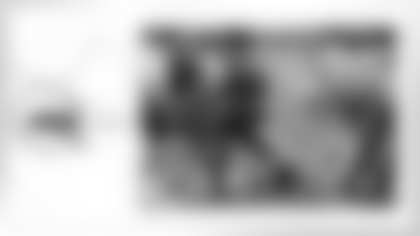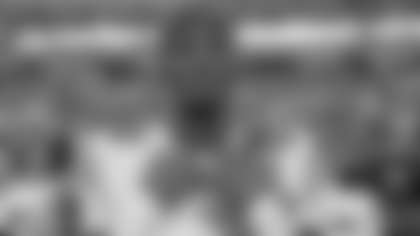The following is the second of four excerpts from theChicago Bears Centennial Scrapbook, which is authored by Hall of Fame writers Dan Pompei and Don Pierson. This passage focuses on the Bears' storied tradition of running backs.
The first face of the Bears was a running back. The greatest Bear ever, in the estimation of Virginia McCaskey, was a running back.
From Red Grange to Walter Payton and beyond, running backs have provided the identity for Chicago Bears offenses. Among the men who carried not only the football but also the franchise were Bronko Nagurski, Ray Nolting, Bill Osmanski, George McAfee, Joe Maniaci, Gary Famiglietti, Hugh Gallarneau, George Gulyanics, Rick Casares, Willie Galimore, Ronnie Bull, Joe Marconi, Gale Sayers, Neal Anderson, Raymont Harris, Anthony Thomas, Thomas Jones, Matt Forte and Jordan Howard.
Running backs have been the cornerstones of almost every Bears team worth remembering. Running backs have been so dominant in the Bears first 100 years that they often meant more to the passing game than wide receivers. In team history, four of the top 10 leaders in receptions are running backs.
The Bears have sent five running backs to the Pro Football Hall of Fame. No fewer than 20 running backs have been named Pro Bowlers. The NFL's Man of the Year award is named after a Bears running back—Payton.
Since the Associated Press started naming an offensive Rookie of the Year in 1967, only one Bears player has won. Of course, it was a running back, Anthony Thomas, in 2001.
If the award had existed in 1965, Sayers, with an NFL record 22 touchdowns, undoubtedly would have won. And had they given the award in 1934, Beattie Feathers would have had been the obvious choice. He became the first player in NFL history to rush for more than 1,000 yards in a season, and his 8.4 average per attempt remains an NFL record. Feathers did it, despite sitting out two games and playing only 11 games.
Bears running backs, it seems, know how to make an entrance. In Forte's first game, September 17, 2008 against Indianapolis, he ran for 123 yards and scored on a 50-yard touchdown. Later that year, Forte broke Sayers' team record for most yards from scrimmage in a season.
Howard, a fifth-round draft pick, was supposed to be a third stringer during his rookie season in 2016. Injuries forced him into the lineup in the third game of the season, and he finished the year as the Bears' all-time leading rookie rusher. He joined Sayers as the only Bears rookie running backs to make the Pro Bowl.
Howard understands what it means to be a Bears running back. When he was a child, he had a blue and orange book he read frequently. It was about Payton.
"It means a lot to be a part of the tradition," Howard said. "When you think about the Bears, you think about Walter Payton, Gale Sayers and all the other great running backs they have in their storied history. It makes you want to do better. It takes a lot to live up to that standard."
The Bears have used 24 first-round draft picks on running backs—a statement about what the franchise wants to see when it looks in the mirror.
In 1941, the Bears had the first and third overall picks. They used both on running backs—Tom Harmon and Norm Standlee. In 1950, the Bears used their first three draft picks on running backs—Chuck Hunsinger, Curly Morrison and John "Kayo" Dottley. They once used first-round picks on running backs in two out of three years, when they chose Billy Anderson and Ron Drzewiecki in 1953 and 1955. The Bears also used a second-round pick on a running back in 1954, and that player, Casares, outperformed both of the first round picks.
Mike Ditka has called Casares the toughest player he ever played with. "I idolized him," Ditka said of Casares, who also was a Golden Gloves boxing champion. "He was a tough guy who didn't wear it outside. He did everything by example. He did nothing by word…Nobody messed with Rick Casares."
The toughest player Ditka ever coached might have been Payton. In 1987, in Payton's final training camp, the 33-year old did extra wind sprints while some teammates were being treated for dehydration. Hall of Fame defensive end Jack Youngblood was hit so hard by Payton once that Youngblood thought his sternum was broken. When Youngblood asked Payton why he did what he did, Payton said, "You were in the way."
If a running back was not tougher than the man trying to tackle him, then he would not belong in the Bears backfield. The greatest power runner in Bears history, and probably NFL history, was Nagurski. He was a giant of a fullback in the 1930s and 40s, standing 6-foot-2 and weighing 230 pounds. Nagurski had a 19-inch collar and a ring finger size of 19.5. And he made a living by putting his head down and barreling into opponents.
"We were at the Polo Grounds when I first ran up against him," Giants linebacker Johnny Dell Isola said in the book, 'The Bears: A 75-Year Celebration.' "It was first and 10 and they gave the ball to Nagurski up the middle. Well, a huge hole opened and I saw him coming. I put my head down and charged into the hole. We met at the line of scrimmage, and you could hear the thud all over the Polo Grounds. I had my arms around his legs and my shoulder dug into him. It was the hardest tackle I ever made, but I made it, and I said to myself, 'Well, I guess that will show you, Nagurski!' Then as I was getting up, I heard the referee shout, 'Second down and two!'"
In a game against Portsmouth in 1933, The Bears were leading 10-7 when Nagurski was called for holding on a Portsmouth punt. The penalty led to a Portsmouth touchdown and a 14-10 lead with two minutes to play. Nagurski returned the kickoff to the 45-yard line. Upon entering the huddle with tears on his cheeks, he said: "This is all my fault. Give me the ball."
Nagurski took it through the end zone, into the dugout, and groundskeepers swore he left a crack in the wall.
Some Bears runners, like McAfee, Sayers and Galimore, inflicted more pain in the open field than at the point of contact. Hall of Fame linebacker Chuck Bednarik once compared trying to tackle Galimore to trying to catch a rabbit. Nicknamed "The Wisp," Galimore wasn't just flash and sparkle, however. Even after having two knee surgeries the previous offseason, he broke five tackles on one incredible 27-yard touchdown run against the Packers in 1963.
Galimore was so central to the Bears identity that when he was killed, along with teammate Bo Farrington in an automobile accident during training camp in 1964, his devastated team could not recover. The Bears finished 5-9, after winning the NFL championship the previous year.
Grange, nicknamed the "Galloping Ghost" by sports writer Grantland Rice, was such a big deal that in 1926, he and his agent, C.C. Pyle asked that Grange be given his own franchise in New York. The NFL refused, so Pyle and Grange started the American Football League.
Ronnie Bull was a big deal in 1962, the second overall pick in the draft. But he never acted like it. Bull accepted whatever role helped the team most. That meant splitting time with Galimore and then Jon Arnett. And when Sayers was drafted in 1965, it meant Bull moving to fullback from halfback.
"It didn't bother me," Bull said. "I just wanted to play. I'm glad I had the privilege to play with him."
More than 20 years later, Neal Anderson showed similar selflessness. He was drafted in the first round in 1986 to be Payton's eventual replacement. With Payton still Payton, Anderson got few carries initially. Anderson devoted himself to special teams and had a dominant season covering kicks and punts. The next year, he played fullback for Payton. After Payton's retirement, Anderson was moved to halfback and he made four straight Pro Bowls.
A Bears running back steps up when he is most needed. Late in the first half in the 2006 NFC championship game, Thomas Jones took control of the game by running on every play of an eight-play, 69-yard drive that gave the Bears their first touchdown of the day and a 16-0 lead. He finished the game with 123 rushing yards and two touchdowns on 19 carries.
No Bear ran with more grace than Sayers. He is remembered as much, however, for his grace off the field and the deep loyalty to a dying teammate, Brian Piccolo. When Piccolo was hospitalized in New York, Sayers went to see him every week.
In the years since Piccolo's death, the Bears have promoted charities that have raised more than $10 million for cancer research—just another aspect of the Bears running back legacy.
TheChicago Bears Centennial Scrapbookcan be purchased by visitingstore.chicagobears.com.






